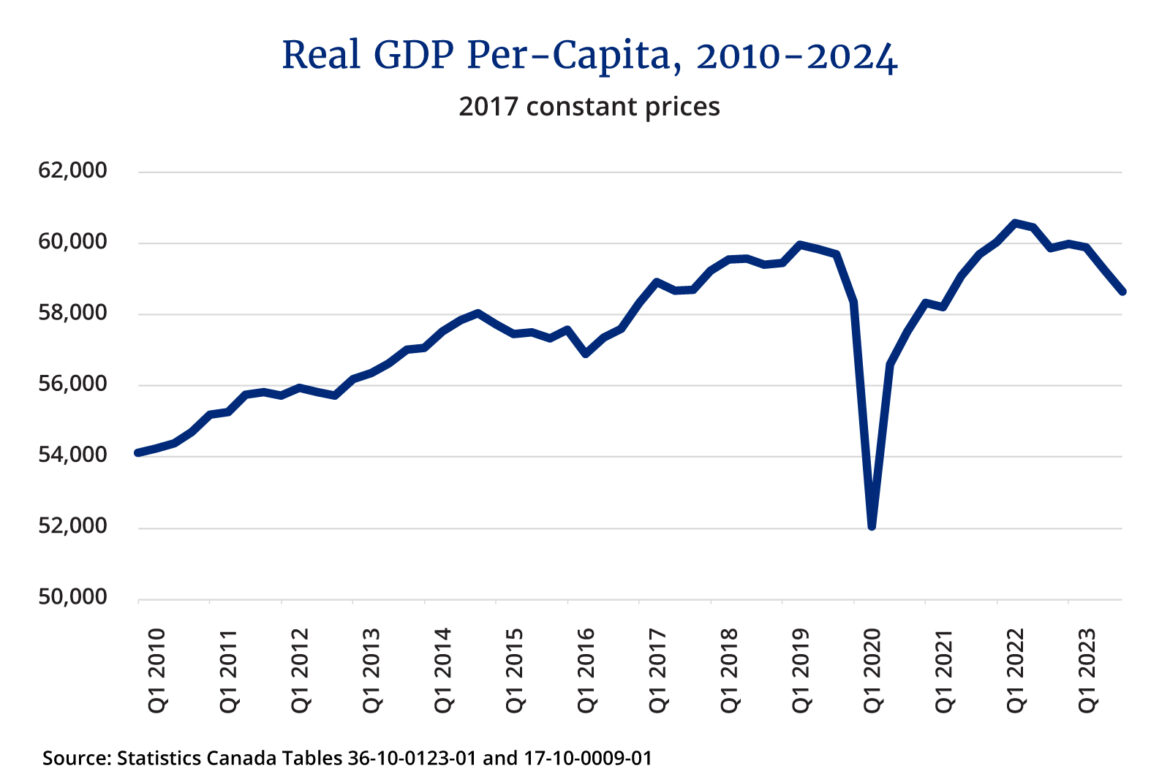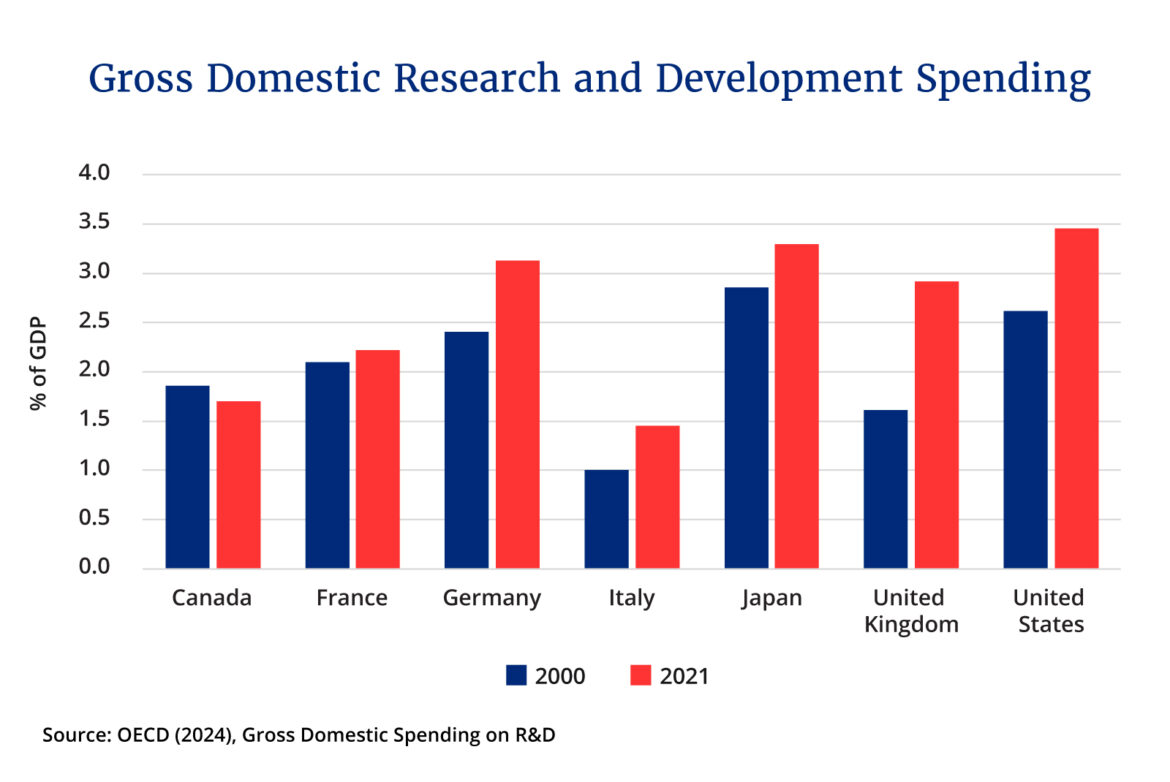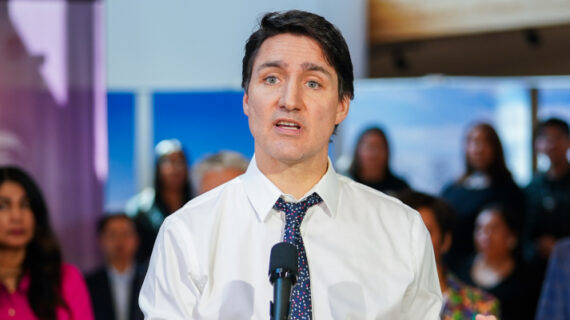Canadian-born, U.S.-based think-tank scholar (and past Hub Dialogues guest) Samuel Hammond recently tweeted:
It only takes two decades of stagnant GDP growth to go from the economic frontier to a middle-income country. The ‘middle income trap’ is a continuous threat.
Although his main observation was about development economics, Canadian policymakers shouldn’t ignore the underlying point. We’re in the midst of a lost economic decade. Our politics should be focused on avoiding a second.
Last month’s release of GDP numbers for the fourth quarter of 2023 showed Canada’s real GDP per capita (a measure commonly used to as a proxy for living standards) declined once again. It’s now effectively at the same level as it was in the fourth quarter of 2014.

There’s reason to believe that this period of stagnation and even declining economic conditions will persist. Unlike most of our peers, Canada isn’t expected to recover its pandemic losses until 2027. Thereafter the OECD projects that among its nearly 40 members, Canada will experience the slowest real GDP per capita growth out to 2060. Globe and Mail columnist Andrew Coyne has rightly described these trends as a “growth crisis.”
The risk isn’t necessarily that Canada slides down the development ladder—though our living standards are declining relative to our peers. The real threat is both less far-reaching and more insidious. Slow growth and stagnant living standards represent serious political economy challenges. They’re the long-run conditions for a zero-sum politics that can lead to a negative spiral of polarization, radicalism, and short-termism. The consequences for individuals and the economy as a whole could be significant.
The Liberal Party’s recent online advertisement—“the economy is not numbers. The economy is people.”—was mocked a bit for its banality. But even if inadvertent, there’s an inherent insight there. Economic growth isn’t merely a statistical expression. It’s the material foundation of a peaceful, stable and ultimately forward-looking society.
Simply put: Canada needs a dedicated policy agenda to restore economic growth and rescue us from a second lost decade.
We’ll consider the possible components of a such pro-growth agenda in subsequent commentary for The Hub. But before we can judge the right mix of policies, we need to identify the causes and sources of our stagnation. We need to understand how we got lost in the first place.
At the heart of Canada’s economic malaise is low productivity growth. Productivity is a fundamental driver of growth in incomes and living standards. The interrelationship between productivity and living standards is axiomatic: the more an economy can produce with less, the better off that society will be materially.

As the economist Paul Krugman famously put it: “Productivity isn’t everything, but, in the long run, it’s almost everything. A country’s ability to improve its standard of living over time depends almost entirely on its ability to raise its output per worker.”
Canada’s long-standing productivity challenges are well documented. What is less well-known however is that they’ve gotten worse in the past several years. From 2015 to 2022, Canada’s real labour productivity grew by only 4 percent compared to growth of 7.5 percent between 2006 to 2014.
Our peers, by contrast, generally saw much higher productivity growth. Between 2015 and 2022, U.S. real labour productivity grew by 7.2 percent. The G7 average was 5.9 percent over the same period.
One consequence of the growing gap between the Canadian and U.S. productivity growth is that Canada’s overall labour productivity is falling relative to the United States. In 1970, Canadian workers were 85 percent as productive as their American counterparts. In 2022, it was 72 percent.
The question of course is: what happened? What’s behind Canada’s stagnant productivity and declining living standards?
There are a myriad of factors but a chief reason is low business investment. Capital is the lifeblood of productivity. If the amount of capital that workers have to use increases (what’s sometimes called “capital deepening”), it will generally enable them to be more productive and produce more output. During the Trudeau era, Canada has experienced the opposite of capital deepening. Our economy is now marked by high levels of government consumption and declining levels of business investment—particularly outside of residential construction.
A recent Statistics Canada report for instance suggests that business investment per worker is down by 20 percent from 2006 to 2021, with a significant portion of that decline coming after 2015. While this partly reflects the downturn in investment in oil and gas production following the busting of the commodity cycle in 2014, there are also other factors at play.
One is the secular shift towards investment in intangible assets such as algorithms, data and software. Firm spending on intangible assets as a share of total fixed assets jumped from 8 percent in 2006 to 17 percent in 2021. Another is a notable decline in entrepreneurship. In 2006, the entry rate for new firms into the Canadian economy was 12 percent. By 2021, it had fallen to just 7 percent.
Canada’s poor record on investment extends to total spending on research and development. It’s the only G7 country that spent less on research and development as a share of GDP in 2021 compared to what it spent in 2000. We’re now the second lowest spender on R&D in the G7 besides Italy.

A final factor behind Canada’s declining GDP per capita is its rapid population growth that’s now outstripping business investment and economic growth more generally. Canada’s population growth between Q4 2022 to Q4 2023 was over 3 percent, which is similar to that of countries like Somalia, Uganda, and Tanzania.
While immigration can have a positive long-term effect on a country’s economic growth trajectory, there are serious questions regarding the absorptive capacity of Canada’s economy to account for the extraordinary rate of growth that we’ve experienced in the past two years. Economists Stéfane Marion and Alexandra Ducharme of National Bank have gone as far as to say that Canada is now in a “population trap” in which the country lacks the infrastructure and capital stock to absorb current population growth and still improve living standards.
Which brings us to the role of federal policy under the Trudeau government. It’s fair to say that the government’s economic policy agenda has done little to abate the twenty-first century trends of slow and sluggish growth and has arguably exacerbated them.
The Trudeau government has advanced an economic strategy of what Lakehead University economist Livio Di Matteo calls extensive growth—that is, a set of policies (such as high immigration and deficit-financed increases to cash transfers) that have grown the total size of the economy but contributed to stagnant and even declining living standards.
Immigration policy is a good (or bad) example. It’s not just that the government has increased overall immigration. It’s also shifted the composition towards lower-skilled newcomers which can distort business investment decisions and depress productivity. There’s a long-run risk here that if business investment doesn’t rise and immigration levels remain high, the Canadian economy will transition to a more labour-intensive one that has lower productivity and living standards relative to our peers. Government policy, in other words, has contributed to an economic imbalance: it’s shifting the economy from a capital-intensive model to a labour-intensive one.
At the same time, high population growth is causing demand to outstrip supply in key areas such as housing, health care, and childcare. So, too, are the Trudeau government’s well-intentioned yet ultimately flawed policies like the $10-a-day childcare subsidies that have increased demand in a sector over which the federal government has little regulatory authority to similarly boost supply. One of us can attest to how bad the situation has gotten after recently being quoted waitlists of one to two years for childcare in downtown Toronto. Similar challenges have been reported across the country.
It’s increasingly clear that Canada needs to shift from state-centric economic development under the Trudeau government that has relied on government consumption and population growth to eke out marginal growth to a bold supply-side agenda that pulls investment into the economy to boost supply in key areas and ultimately increase productivity and living standards.
We must move our overall growth model from one of extensive growth (driven primarily by government consumption and high levels of immigration) to one of intensive growth (which is dependent on capital investment and rising productivity). One might think of the difference as stimulative versus sustainable growth. We’ll be back in the future with some policy ideas that ought to form the basis of such an agenda.
But the first order of business is to understand the magnitude of the challenge and the risks of not confronting it. Canadian living standards are now what they were in 2014. That amounts to a lost decade. The overwhelming imperative of our politics and policy must be that it doesn’t extend to a second decade. We cannot afford to learn of the consequences.




